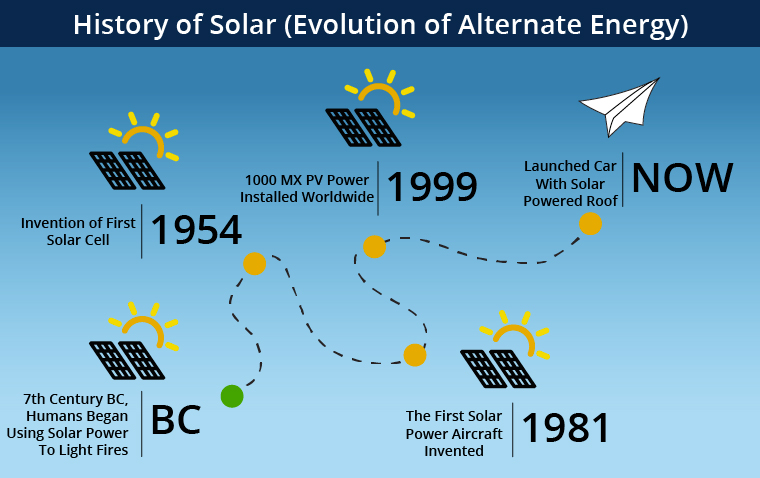




Are you aware that scientists have spent thousands of years trying to understand the promising solar energy and its application?
Yes, understanding the 'how' of harnessing the Sun's power and meaningful use has been an uphill task that has ignited various scientists' interest in developing a concrete solution.
Below is a timeline of multiple achievements and milestones covering various human efforts to extract and use solar energy.
How is solar energy extracted from sun rays? Through the use of Photovoltaic devices. These are a particular type of metal that, when exposed to sunlight, use the photovoltaic effect to produce electricity.
It is estimated that the knowledge about this photovoltaic effect has existed for roughly two centuries, and for this reason, our history about the solar cells begins here.
Theoretically, it is believed that humans began to use solar energy by 7th century B.C. History reviews that humans were using sunlight to ignite the fire using magnifying glass materials.
700 BC- The use of a magnifying lens to put on Sunlit Fires' Heat Ray'. Do you know by the 7th century B.C humans could make fire using a magnifying glass to concentrate sunlight?
For instance, around. 214-212 B.C. historians hypnotize that Archimedes' a great Greek inventor, was able to apply solar energy by creating heat rays using multiple mirrors to concentrate sunlight.
It is believed that he destroyed several ships by concentrating sunlight on those ships belonging to Greek enemies especially during the Siege of Syracuse.
Although this Archimedes' invention's validity is not apparent, various experiments have shown that it could be possible but more unlikely to have been executed.
Romans are also known to use mirrors to harness the solar power and using it as light torches during their religious ceremonies. The use of "burning mirrors" became prevalent among Roman, Greeks, and later to the Chinese civilization.
When was the first invention of the solar panels?
A solar oven, often known as the solar cooker, uses the heat created by concentrating sunlight to heat drinks or food. Solar cookers are in use to date and are cheaper and efficient compared to the previous models.
They are the most popular heating solutions, especially world parts, with limited access to electricity. The device relies only on sunlight to function, and this means no fuel or electrical power is need for it to work.
The first solar oven was invented in 1767 by Horace De Saussure, a renowned Swiss Physicist. By the time of invention, nobody could have thought that this invention could be among the most helpful innovations for the next two centuries by helping people prepare their lunch and dinner without using firewood.
One of the most critical years in the history of solar panels was 1839 when Edmund Becquerel, a 19-year-old French physicist, discovered that there is a voltage difference when specific material is exposed to sunlight created.
With his little knowledge about the photovoltaic effect, Edmund Becquerel dint understands that his discovery would form the basis of solar power in use in modern today.
In 1873, Willoughby Smith, a staunch English engineer, coined Photoconductivity in Selenium, especially in its solid-state, which was another significant discovery that led to a great milestone in the solar energy industry.
While advancing the Smiths discovery three years earlier, an English professor, together with his best student, Richard Evans Day, observed a flow of electrical current when specific material was exposed to sunlight.
Two electrodes attached to a selenium plate were used to make the tiny electrical current after exposing those plates to the light.
The credit goes to Charles Fritts, an American inventor who was the first person to design a successive solar cell plan. His 19th-century simple Photovoltaic Cell design was based on selenium wafers.
Although most people aren't aware of Albert Einstein's photoelectrical effect paperwork, he is famous for his outstanding scientific milestone in the human race.
He is the first person to formulate the photon theory of light, an idea that explains how light can dislodge 'remove or liberate' an electron from a metal surface.
Sixteen years later, in 1921, after submitting his photon theory of light paper, he received the Nobel Prize to discover a tremendous scientific breakthrough.
The credit goes to a Polish scientist, Jan Czochralski, for figuring out a technique in which to grow single-crystal silicon. His discovery lay the foundation for the creation of solar cells using silicon metal.
The credit goes to three scientists, namely, Gerald Pearson, a member of Bell Labs, David Chapin, and Calvin Fuller. Their work led to the creation of the world's first solar cell (photovoltaic cell). In simple terms, these men came up with a device that could convert sunlight into electricity.
Many maintain that their silicon photovoltaic (PV) cell invention symbolizes the real PV technology invention. The first device could consistently power a considerable electrical device for more than two hours a day.
However, the first silicon photovoltaic cell could only operate at 4% efficiency, below a quarter of modern solar cells capacity. They later advanced its performance (conversions efficiently), increasing it from 4% to 11%.
Other significant achievements in the history of solar panels. The use of solar panels to power outer space devices. The use of solar technology in outer space is one of the most recent solar energy industry achievements. The outer space solar panels were used to run satellites.
A good example is solar panels power Explorer III, Vanguard II, and Sputnik-3 satellites in 1958. Others include creating the first solar residence in 1973 by a team of scientists at the University of Delaware, Improving solar conversion efficiency from 8% to 14% by Hoffman Electronics amid 1957 and 1960.
By 2016, the conversion efficiency had reached 34.5% efficiency and innovation from The University of South Wales.